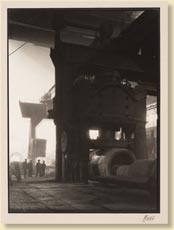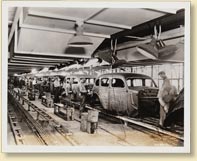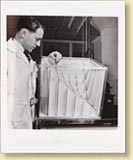The Production: A Cooperative Enterprise
What the industrial worker wants is . . . a method of living in social relationship with other people and . . . as part of this an economic function for and value to the group.Elton Mayo,
Professor of Industrial Research, Harvard Business School, 1933
 The thousands of images Ayres and Davenport received revealed that behind the product lay a corporate system driven by power, efficiency, and industrial research. These recurring themes provided a compelling arsenal of symbols that both celebrated American capitalist might and combated negative publicity generated by labor unions and the realities of the Depression. Ayres and Davenport showed no interest in collecting photographs illustrating the darker side of industrial unrest; noticeably absent from the archive, for example, are stark scenes of unemployment lines, labor strikes, or tenant farmers.
The thousands of images Ayres and Davenport received revealed that behind the product lay a corporate system driven by power, efficiency, and industrial research. These recurring themes provided a compelling arsenal of symbols that both celebrated American capitalist might and combated negative publicity generated by labor unions and the realities of the Depression. Ayres and Davenport showed no interest in collecting photographs illustrating the darker side of industrial unrest; noticeably absent from the archive, for example, are stark scenes of unemployment lines, labor strikes, or tenant farmers.

 Economic and social instability, however, increasingly became the impetus for business schools such as Harvard to consider the question of the human factor. During the 1930s the Business School doubled the number of classes it offered in industrial relations. In courses such as “Human Problems of Administration” and “Personnel Research” students became familiar with prevailing management theories that espoused the importance of a cooperative system and common purpose among workers. They would find this principle repeatedly underscored in the industrial photograph collection. In John Mudd’s atmospheric image, factory employees harness the might of Midvale Steel Company’s massive 9,000-ton forging press. In publicity shots for the Chrysler Corporation, employees participate in the exemplary process of standardization and cooperative efficiency—the assembly line, and an “industrial doctor of science,” as the accompanying caption states, performs “basic data research” aimed at formulating the best possible car lubricant.
Economic and social instability, however, increasingly became the impetus for business schools such as Harvard to consider the question of the human factor. During the 1930s the Business School doubled the number of classes it offered in industrial relations. In courses such as “Human Problems of Administration” and “Personnel Research” students became familiar with prevailing management theories that espoused the importance of a cooperative system and common purpose among workers. They would find this principle repeatedly underscored in the industrial photograph collection. In John Mudd’s atmospheric image, factory employees harness the might of Midvale Steel Company’s massive 9,000-ton forging press. In publicity shots for the Chrysler Corporation, employees participate in the exemplary process of standardization and cooperative efficiency—the assembly line, and an “industrial doctor of science,” as the accompanying caption states, performs “basic data research” aimed at formulating the best possible car lubricant.
- Baker Library | Historical Collections | Site Credits | Digital Accessibility
- Contact Email: histcollref@hbs.edu
